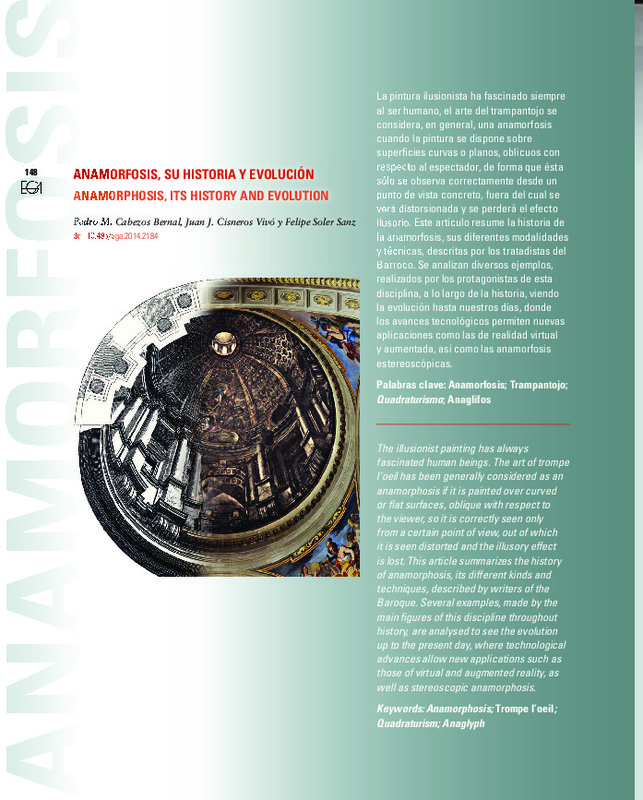JavaScript is disabled for your browser. Some features of this site may not work without it.
Buscar en RiuNet
Listar
Mi cuenta
Estadísticas
Ayuda RiuNet
Admin. UPV
Anamorfosis, su historia y evolución
Mostrar el registro sencillo del ítem
Ficheros en el ítem
| dc.contributor.author | Cabezos Bernal, Pedro Manuel
|
es_ES |
| dc.contributor.author | Cisneros Vivó, Juan José
|
es_ES |
| dc.contributor.author | Soler Sanz, Felipe
|
es_ES |
| dc.date.accessioned | 2016-12-28T08:57:43Z | |
| dc.date.available | 2016-12-28T08:57:43Z | |
| dc.date.issued | 2014-05-15 | |
| dc.identifier.issn | 1133-6137 | |
| dc.identifier.uri | http://hdl.handle.net/10251/75848 | |
| dc.description.abstract | [EN] The illusionist painting has always fascinated human beings. The art of trompe l’oeil has been generally considered as an anamorphosis if it is painted over curved or flat surfaces, oblique with respect to the viewer, so it is correctly seen only from a certain point of view, out of which it is seen distorted and the illusory effect is lost. This article summarizes the history of anamorphosis, its different kinds and techniques, described by writers of the Baroque. Several examples, made by the main figures of this discipline throughout history, are analysed to see the evolution up to the present day, where technological advances allow new applications such as those of virtual and augmented reality, as well as stereoscopic anamorphosis | es_ES |
| dc.description.abstract | [ES] La pintura ilusionista ha fascinado siempre al ser humano, el arte del trampantojo se considera, en general, una anamorfosis cuando la pintura se dispone sobre superficies curvas o planos, oblicuos con respecto al espectador, de forma que ésta sólo se observa correctamente desde un punto de vista concreto, fuera del cual se verá distorsionada y se perderá el efecto ilusorio. Este artículo resume la historia de la anamorfosis, sus diferentes modalidades y técnicas, descritas por los tratadistas del Barroco. Se analizan diversos ejemplos, realizados por los protagonistas de esta disciplina, a lo largo de la historia, viendo la evolución hasta nuestros días, donde los avances tecnológicos permiten nuevas aplicaciones como las de realidad virtual y aumentada, así como las anamorfosis estereoscópicas. | es_ES |
| dc.language | Español | es_ES |
| dc.language | Inglés | es_ES |
| dc.publisher | Universitat Politècnica de València | |
| dc.relation.ispartof | EGA. Revista de Expresión Gráfica Arquitectónica | |
| dc.rights | Reserva de todos los derechos | es_ES |
| dc.subject | Anamorphosis | es_ES |
| dc.subject | Trompe l’oeil | es_ES |
| dc.subject | Quadraturism | es_ES |
| dc.subject | Anaglyph | es_ES |
| dc.subject | Anamorfosis | es_ES |
| dc.subject | Trampantojo | es_ES |
| dc.subject | Quadraturismo | es_ES |
| dc.subject | Anaglifos | es_ES |
| dc.title | Anamorfosis, su historia y evolución | es_ES |
| dc.title.alternative | ANAMORPHOSIS, ITS HISTORY AND EVOLUTION | es_ES |
| dc.type | Artículo | es_ES |
| dc.date.updated | 2016-12-23T13:26:15Z | |
| dc.identifier.doi | 10.4995/ega.2014.2184 | |
| dc.rights.accessRights | Abierto | es_ES |
| dc.contributor.affiliation | Universitat Politècnica de València. Departamento de Expresión Gráfica Arquitectónica - Departament d'Expressió Gràfica Arquitectònica | es_ES |
| dc.contributor.affiliation | Universitat Politècnica de València. Escuela Técnica Superior de Arquitectura - Escola Tècnica Superior d'Arquitectura | es_ES |
| dc.description.bibliographicCitation | Cabezos Bernal, PM.; Cisneros Vivó, JJ.; Soler Sanz, F. (2014). Anamorfosis, su historia y evolución. EGA. Revista de Expresión Gráfica Arquitectónica. 19(23):148-161. https://doi.org/10.4995/ega.2014.2184 | es_ES |
| dc.description.accrualMethod | SWORD | es_ES |
| dc.relation.publisherversion | https://doi.org/10.4995/ega.2014.2184 | es_ES |
| dc.description.upvformatpinicio | 148 | es_ES |
| dc.description.upvformatpfin | 161 | es_ES |
| dc.type.version | info:eu-repo/semantics/publishedVersion | es_ES |
| dc.description.volume | 19 | |
| dc.description.issue | 23 | |
| dc.identifier.eissn | 2254-6103 |








